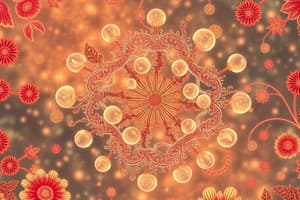Podcast
Questions and Answers
What is the primary function of the inner membrane of mitochondria?
What is the primary function of the inner membrane of mitochondria?
- Is involved in the production of mitochondrial DNA
- Regulates the movement of molecules selectively (correct)
- Allows free movement of all molecules
- Contains the proton gradient for ATP synthesis
Which of the following best describes the cristae in mitochondria?
Which of the following best describes the cristae in mitochondria?
- The area where glucose is synthesized
- Invaginations that increase surface area for reactions (correct)
- Fluid-filled space containing DNA
- The outermost layer of the organelle
From which source does mitochondrial DNA primarily originate?
From which source does mitochondrial DNA primarily originate?
- Maternal DNA only (correct)
- Primarily from nuclear DNA
- Only from paternal DNA
- Both parents equally
What is produced as a byproduct during the electron transport chain in mitochondria?
What is produced as a byproduct during the electron transport chain in mitochondria?
What sustains the proton gradient required for ATP production in mitochondria?
What sustains the proton gradient required for ATP production in mitochondria?
Which cycle takes place in the mitochondrial matrix and produces high-energy electron carriers?
Which cycle takes place in the mitochondrial matrix and produces high-energy electron carriers?
What is the role of ribosomes found in the mitochondrial matrix?
What is the role of ribosomes found in the mitochondrial matrix?
Which of the following processes occurs in the mitochondrial matrix?
Which of the following processes occurs in the mitochondrial matrix?
What is produced by the Krebs cycle?
What is produced by the Krebs cycle?
Which process is involved in the detoxification of ammonia?
Which process is involved in the detoxification of ammonia?
What is the primary role of cytochrome C in mitochondria?
What is the primary role of cytochrome C in mitochondria?
What percentage of mitochondrial proteins are synthesized in the mitochondria itself?
What percentage of mitochondrial proteins are synthesized in the mitochondria itself?
Which process synthesizes glucose from non-carbohydrate sources?
Which process synthesizes glucose from non-carbohydrate sources?
What is the significance of mitochondrial DNA (mtDNA)?
What is the significance of mitochondrial DNA (mtDNA)?
During apoptosis, the levels of which protein decrease to allow cytochrome C release?
During apoptosis, the levels of which protein decrease to allow cytochrome C release?
What do the mitochondria and ribosomes resemble, indicating their prokaryotic origin?
What do the mitochondria and ribosomes resemble, indicating their prokaryotic origin?
Flashcards are hidden until you start studying
Study Notes
Inner Mitochondrial Membrane Function
- The inner membrane of mitochondria is the site of electron transport and ATP production.
- It is impermeable to most molecules, requiring specific transport proteins for passage.
Cristae Description
- The cristae are folded invaginations of the inner mitochondrial membrane, increasing its surface area.
- This enhances the efficiency of ATP production by providing more space for electron transport and ATP synthase.
Mitochondrial DNA Origin
- Mitochondrial DNA (mtDNA) is primarily inherited maternally.
Electron Transport Chain Byproduct
- Water (H2O) is produced as a byproduct during the electron transport chain in mitochondria.
- This occurs as the final electron acceptor, oxygen, is reduced.
Proton Gradient Maintenance
- The electron transport chain pumps protons (H+) from the mitochondrial matrix across the inner membrane into the intermembrane space, generating the proton gradient.
- This gradient is essential for ATP production by ATP synthase.
Mitochondrial Matrix Cycle
- The Krebs cycle (or citric acid cycle) takes place in the mitochondrial matrix.
- This cycle generates high-energy electron carriers, such as NADH and FADH2, which are essential for the electron transport chain.
Mitochondrial Ribosome Function
- The ribosomes found in the mitochondrial matrix are responsible for synthesizing mitochondrial proteins.
Mitochondrial Matrix Processes
- Krebs cycle, fatty acid oxidation, and amino acid catabolism all occur in the mitochondrial matrix.
Krebs Cycle Output
- The Krebs cycle produces ATP, NADH, FADH2, and CO2.
- These products are essential for ATP production and other metabolic processes.
Ammonia Detoxification
- The urea cycle, which detoxifies ammonia, occurs primarily in the liver.
- Mitochondria play a role in ammonia detoxification by converting ammonia to urea.
Cytochrome C Role
- Cytochrome C is a crucial protein in the electron transport chain.
- It acts as an electron carrier and helps maintain the proton gradient essential for ATP production.
Mitochondrial Protein Synthesis
- Only about 5% of mitochondrial proteins are synthesized within the mitochondria itself.
- The rest are encoded by nuclear DNA and imported from the cytoplasm.
Gluconeogenesis
- Gluconeogenesis is the process of synthesizing glucose from non-carbohydrate sources, such as amino acids and glycerol.
- This process occurs in the liver and kidneys and utilizes energy generated by mitochondria.
Mitochondrial DNA Significance
- mtDNA plays a significant role in cellular energy production and is essential for the proper functioning of mitochondria.
- It is also used in tracing ancestry and studying evolutionary relationships.
Apoptosis Protein Level Decrease
- During apoptosis, Bcl-2 protein levels decrease, allowing cytochrome C to be released from the mitochondria.
- This event triggers a cascade of events leading to programmed cell death.
Mitochondrial-Ribosomal Resemblance
- Mitochondria and ribosomes share structural similarities with bacteria.
- This suggests that they likely originated from endosymbiotic bacteria that were engulfed by early eukaryotic cells.
Studying That Suits You
Use AI to generate personalized quizzes and flashcards to suit your learning preferences.



